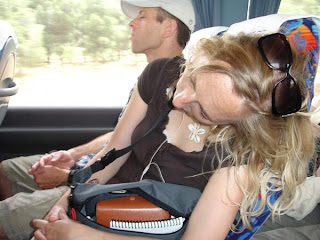 Sergeant Gunnerson (we love him) commanded yet another 6:00am wake-up call today, for a 6:30am sacrament service (is the spirit up that early?) and 7:30am departure.
Sergeant Gunnerson (we love him) commanded yet another 6:00am wake-up call today, for a 6:30am sacrament service (is the spirit up that early?) and 7:30am departure.
After inhaling some breakfast, now with more fiber since the Egyptian heebie-jeebies have left us, we scurried off to the first stop where Jesus was raised—Nazareth. Rolli, an amazing India-born Jewish convert, has taken the reigns as tour guide, and our fearless driver, Adnan (aka--“Fast Eddie”), who has been driving BYU students for 17 years, takes great care of us and secures us great deals on lunch. In Nazareth we visited a well excavated Nazarene village from the time of Christ, and there saw a wine press (FYI—done with bare feet as to not crush the bitter seeds), a garden watchtower, olive oil press (Scott P. made a great….…donkey), a large underground cistern, and a rebuilt ancient synagogue. In the synagogue Brother Gunnerson read some beautiful excerpts from the New Testament when Christ declared himself as the Messiah in the Nazarene synagogue and was subsequently thrown out.


Next stop (of five), Mt. Tabor, believed by many to be the actual Mount of Transfiguration, situated along the fertile Jezreel Valley. After a taxi-ride up a series of 5 mph switch-back U-turns, (not driven at anywhere near 5 mph; it seemed our driver’s principal goal was to get our van up on two wheels) we reached the top. There we enjoyed many spiritual moments and time to contemplate the sacredness of the area as Brother Gunnerson read multiple excerpts from the scriptures and then concluded with a short but powerful testimony meeting. Upon leaving the top of Mt. Tabor, Shay, straggling behind, was trapped by the electric gate in the Catholic convent. We barely rescued her from the nuns who had slapped a habit, robe, and knee-highs on her and were about to make her take her vows of celibacy.
Our third stop was Tel Megidda, or what we know as Armageddon. We first pounded down some falafel sandwiches, then proceeded to see the ancient ruins (dating from before the days of Solomon) through sweltering heat wondering why 25 civilizations had chosen this spot to build upon. We descended into a blissfully cool tunnel built underneath the city to link the outside water source into the city for times of war, quite an amazing feat.
Then off to the beautiful coastal city of Caesarea, the Roman capital of the area during the time of Christ. This huge metropolis, built predominantly by Herod the Great, provided numerous ruins, including a large theater and hippodrome, as well as beautiful costal views and breezes.


Alas we concluded our day by driving north up the coast to Haifa, and were finally able to frolic in Mediterranean Sea, engaging in a game of tag, Frisbee, and just a little chillin’ in the sun for some much needed R & R.

 Some time later he motioned to the distant horizon to some small piles of dirt. These, he informed us, were phosphate waste piles. Other than these Jordanian tourist attractions The SC offered very little in the way of sites.
Some time later he motioned to the distant horizon to some small piles of dirt. These, he informed us, were phosphate waste piles. Other than these Jordanian tourist attractions The SC offered very little in the way of sites. This location indicated in the Bible as the spot where Moses first saw the promised land of Israel is located in northern Jordan. It has a cobble stone path to the top and is maintained by some Franciscan monks.
This location indicated in the Bible as the spot where Moses first saw the promised land of Israel is located in northern Jordan. It has a cobble stone path to the top and is maintained by some Franciscan monks.





 Now the tour is over and we are given many options for our personal pleasure or pain.
Now the tour is over and we are given many options for our personal pleasure or pain. 









 Rising to the top of the mountain, some witnessed amazing glimpses of shooting stars and the feeling that they were so close to the constellations they could almost reach out and touch them. Others were more excited by the opportunity to buy Mars bars from at least six different locations along the way. After reaching the top, many huddled under blankets gazing up in awe at the star-studded heavens. One can certainly understand why Moses came to such a place to talk to God.
Rising to the top of the mountain, some witnessed amazing glimpses of shooting stars and the feeling that they were so close to the constellations they could almost reach out and touch them. Others were more excited by the opportunity to buy Mars bars from at least six different locations along the way. After reaching the top, many huddled under blankets gazing up in awe at the star-studded heavens. One can certainly understand why Moses came to such a place to talk to God.













 The big pyramid blocks prove a perfect spot for our first group photo...until the pyramid police chide us for clibming too high.
The big pyramid blocks prove a perfect spot for our first group photo...until the pyramid police chide us for clibming too high. 












